Nature, May 14, 2025
A study published in Scientific Reports by Nature (2025) has shed light on the role of neonatal factors in determining the quality of umbilical cord blood (UCB) units. The study found that placental weight is the strongest predictor of UCB volume, total nucleated cells (TNCs), and CD34+ cells—key criteria for evaluating the viability of UCB for hematopoietic stem cell transplantation.
Research Background
Umbilical cord blood has long been used as a rich source of hematopoietic stem cells, serving as an alternative to bone marrow transplantation. However, the majority of collected UCB units are discarded because they do not meet the minimum thresholds for CD34+ cells or TNC counts. This leads to high collection and storage costs for UCB banks, while the actual utilization rate remains low.
This study was conducted to identify which neonatal factors can predict the quality of UCB in advance, thereby optimizing collection processes and enhancing the clinical value of stored units.
Methods and Study Design
- Location: Mansoura University Hospital, Egypt
- Study Sample: 150 randomly selected cesarean deliveries
- Collected Parameters:
- Placental weight
- Neonatal birth weight and length
- Head and chest circumference
- Gestational age
- Umbilical cord length
- Fetal sex
- Collected UCB volume
- TNC and CD34+ cell counts
Key Findings
- Placental weight showed the strongest correlation with:
- UCB volume
- CD34+ cell count
- Total nucleated cell count (TNCs)
- Birth weight, head and chest circumference, and umbilical cord length also positively correlated with UCB quality.
- Longer gestational age (≥ 39 weeks) contributed to increased volume and stem cell concentration in UCB.
- Fetal sex had no significant effect on UCB parameters.
Clinical Significance and Application
The study presents a key recommendation: placental weight should be considered as a primary screening criterion when deciding whether to collect UCB for storage. UCB banks can use this information to select higher-quality units, thereby:
- Improving the efficiency of UCB unit use in transplantation
- Reducing long-term storage costs
- Enhancing the success rate of transplants, particularly in children and smaller adult recipients
References
This article was translated and summarized from the original publication:Darwish, A., Bassiouny, M.R., Mansour, A.K. et al. Neonatal factors impacting umbilical cord blood unit characteristics. Sci Rep 15, 16776 (2025). https://doi.org/10.1038/s41598-025-96829-3
Source: Nature
Link: https://www.nature.com/articles/s41598-025-96829-3#citeas






